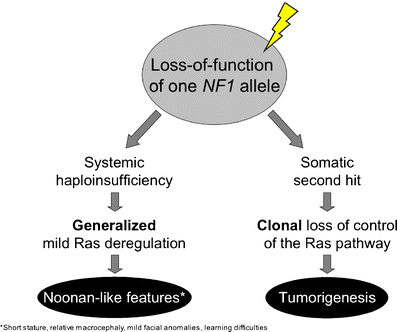An unexpected new role of mutant Ras: perturbation of human embryonic development
- PMID: 17211612
- PMCID: PMC1820751
- DOI: 10.1007/s00109-006-0135-4
An unexpected new role of mutant Ras: perturbation of human embryonic development
Abstract
The Ras signaling pathway controls important cellular responses to growth factors, and somatic mutations in RAS genes and other components of the Ras pathway, such as PTPN11 (encoding the protein-tyrosine phosphatase SHP-2) and BRAF, are found in human malignancies. Ras proteins are guanosine nucleotide-binding proteins that cycle between active guanosine triphosphate (GTP)-bound and inactive guanosine diphosphate (GDP)-bound conformations. Neoplasia-associated Ras mutations frequently affect amino acids G12, G13, or Q61 and decrease the intrinsic guanosine triphosphatase (GTPase) activity by ten- to twentyfold. The GTPase activity is crucial for Ras inactivation by hydrolysis and release of a phosphate group from Ras.GTP to produce Ras.GDP. We and others have recently discovered germline mutations in the KRAS gene in individuals diagnosed with Noonan and cardio-facio-cutaneous (CFC) syndrome, two clinically overlapping disorders characterized by short stature, distinct facial anomalies, heart defects, and other abnormalities. Noonan syndrome-associated mutations V14I and T58I K-Ras activate Ras but have milder biochemical effects than somatic mutations encountered in cancers, offering an explanation why these K-Ras lesions are tolerated during embryonic development. Together with recent findings of BRAF, MEK1, and MEK2 mutations in CFC syndrome and HRAS mutations in Costello syndrome, another clinically related disorder, it has now become clear that Noonan-like features (short stature, relative macrocephaly, facial anomalies, learning difficulties) that are found in these three related disorders are a result of constitutive activation of the Ras-Raf-extracellular signal-regulated and mitogen-activated protein kinase pathway.
Figures




References
-
- {'text': '', 'ref_index': 1, 'ids': [{'type': 'DOI', 'value': '10.1016/j.tcb.2004.09.014', 'is_inner': False, 'url': 'https://doi.org/10.1016/j.tcb.2004.09.014'}, {'type': 'PubMed', 'value': '15519853', 'is_inner': True, 'url': 'https://pubmed.ncbi.nlm.nih.gov/15519853/'}]}
- Repasky GA, Chenette EJ, Der CJ (2004) Renewing the conspiracy theory debate: does Raf function alone to mediate Ras oncogenesis? Trends Cell Biol 14:639–647 - PubMed
-
- {'text': '', 'ref_index': 1, 'ids': [{'type': 'DOI', 'value': '10.1126/science.1062023', 'is_inner': False, 'url': 'https://doi.org/10.1126/science.1062023'}, {'type': 'PubMed', 'value': '11701921', 'is_inner': True, 'url': 'https://pubmed.ncbi.nlm.nih.gov/11701921/'}]}
- Vetter IR, Wittinghofer A (2001) The guanine nucleotide-binding switch in three dimensions. Science 294:1299–1304 - PubMed
-
- {'text': '', 'ref_index': 1, 'ids': [{'type': 'PubMed', 'value': '11960693', 'is_inner': True, 'url': 'https://pubmed.ncbi.nlm.nih.gov/11960693/'}]}
- Donovan S, Shannon KM, Bollag G (2002) GTPase activating poteins: critical regulators of intracellular signaling. BBA Rev Cancer 1602:23–45 - PubMed
-
- {'text': '', 'ref_index': 1, 'ids': [{'type': 'PubMed', 'value': '2547513', 'is_inner': True, 'url': 'https://pubmed.ncbi.nlm.nih.gov/2547513/'}]}
- Bos JL (1989) Ras oncogenes in human cancer: a review. Cancer Res 49:4682–4689 - PubMed
-
- {'text': '', 'ref_index': 1, 'ids': [{'type': 'DOI', 'value': '10.1016/S1535-6108(04)00085-6', 'is_inner': False, 'url': 'https://doi.org/10.1016/s1535-6108(04)00085-6'}, {'type': 'PubMed', 'value': '15093544', 'is_inner': True, 'url': 'https://pubmed.ncbi.nlm.nih.gov/15093544/'}]}
- Tuveson DA, Shaw AT, Willis NA, Silver DP, Jackson EL, Chang S, Mercer KL, Grochow R, Hock H, Crowley D, Hingorani SR, Zaks T, King C, Jacobetz MA, Wang L, Bronson RT, Orkin SH, DePinho RA, Jacks T (2004) Endogenous oncogenic K-ras(G12D) stimulates proliferation and widespread neoplastic and developmental defects. Cancer Cell 5:375–387 - PubMed
Publication types
MeSH terms
Substances
LinkOut - more resources
Full Text Sources
Research Materials
Miscellaneous

